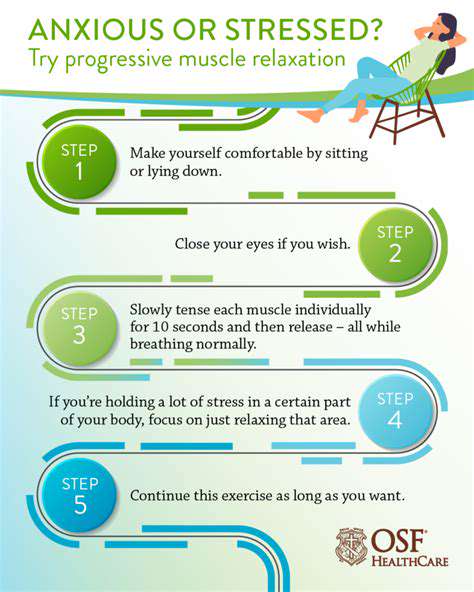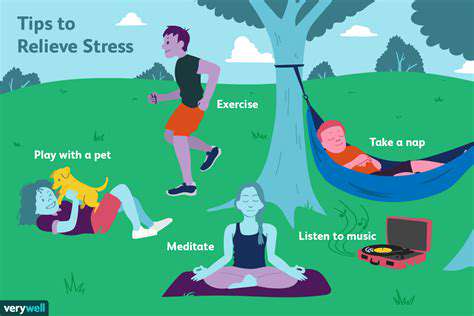Effective Relaxation Practices for Anxiety Relief
Understanding the Spectrum of Anxiety
Anxiety isn't a one-size-fits-all experience; it shows up differently for everyone, ranging from constant worrying and racing thoughts to physical signs like a pounding heart or trouble breathing. Spotting how your anxiety uniquely appears is the first step toward finding what sets it off. Getting familiar with these often intense feelings creates a solid starting point for managing them better, helping you achieve greater peace and balance.
Various anxiety disorders—like generalized anxiety, panic attacks, or social anxiety—each come with their own triggers. Knowing which type you're dealing with makes it easier to address the root causes and tailor coping strategies that work for you.
Recognizing Physical Symptoms
Tune in to your body's reactions when anxiety strikes. Do your hands get clammy? Do headaches or stomachaches appear? These physical cues can reveal a lot about what's triggering you. Linking these bodily responses to certain situations or thoughts helps uncover patterns in how your body reacts to stress.
Often, these physical signs show up before the emotional ones, acting like an early alert system. Catching them early lets you step in before anxiety spirals out of control.
Identifying Environmental Triggers
Your surroundings play a big role in sparking anxiety. Think about places, scenarios, or people that consistently leave you feeling uneasy. Is it packed spaces? Certain social interactions? A particular time of day? Pinpointing these triggers helps you plan ways to avoid or handle them better.
For instance, if a crowded store sets you off, try shopping at quieter times. Small adjustments like these can make a huge difference in how you feel day to day.
Analyzing Emotional Triggers
Dive deeper into the emotions tied to your anxiety. What thoughts pop up when you're anxious? Are you imagining worst-case scenarios? Being overly hard on yourself? Understanding these emotional patterns is key to getting to the heart of your anxiety.
Once you spot these triggers, you can work on shifting negative thought habits and fostering a more balanced mindset. This kind of self-reflection is a game-changer for long-term relief.
Examining Behavioral Patterns
Look at how you act when anxiety hits. Do you skip social events or put off tasks? Do you rely on quick fixes like too much coffee or withdrawing from others?
Seeing these habits clearly is the first step to breaking free from them. Once you recognize what you're doing, you can swap unhelpful behaviors for healthier strategies that tackle anxiety at its source.
Considering Lifestyle Factors
Take stock of daily habits that might be feeding your anxiety. Are you sleeping enough? Eating well? Moving your body regularly? These factors heavily influence your mood and stress levels.
Small, consistent changes—like prioritizing sleep, choosing nutritious foods, and staying active—can dramatically lower anxiety and boost overall well-being. Over time, these tweaks build resilience against stress, leading to fewer anxiety flare-ups and a better quality of life.
Progressive Muscle Relaxation: Releasing Physical Tension

Understanding Progressive Muscle Relaxation
Progressive muscle relaxation (PMR) is a simple yet powerful way to ease tension and promote calm. The technique involves deliberately tensing then relaxing different muscle groups throughout the body. This practice helps you become aware of—and release—physical tightness often linked to stress. The magic lies in learning to distinguish between tension and relaxation, which gives you more control over your body's stress response.
The Benefits of Progressive Muscle Relaxation
PMR does more than just help you unwind. Regular practice can lower stress, improve sleep, and reduce anxiety by calming the nervous system. It's particularly helpful for relieving tension-related discomfort like headaches or back pain, offering both mental and physical relief.
Steps in Progressive Muscle Relaxation
The method works through each major muscle group systematically. Start by getting comfortable in a quiet space where you won't be interrupted. The key is moving slowly and focusing completely on each area as you tense and release it.
Techniques for Enhanced Relaxation
Pairing PMR with deep breathing amplifies its effects. Slow, intentional breaths help slow your heart rate and deepen relaxation. Adding mindfulness—paying close attention to bodily sensations—can make the practice even more effective at quieting anxious thoughts.
Addressing Specific Muscle Groups
The technique typically starts at the feet and moves upward. This thorough approach ensures no area gets overlooked. Noticing which muscles hold the most tension helps you personalize the practice for maximum benefit.
Finding a Suitable Practice Routine
Consistency matters more than duration when starting PMR. Even five minutes daily can make a difference. Creating a dedicated relaxation ritual—same time, same cozy spot—helps turn it into a habit that sticks. Begin with shorter sessions and gradually increase as you become more comfortable with the technique.
Preventive maintenance is crucial for the longevity and reliability of transmission systems. By identifying and addressing potential issues before they escalate, organizations can significantly reduce downtime and repair costs. This proactive approach extends the service life of equipment, ensuring that systems operate at peak performance.
Deep Breathing Exercises: Calming the Nervous System
Understanding the Science Behind Deep Breathing
Deep breathing isn't just about taking big breaths—it's a direct line to calming your nervous system. When you breathe deeply, you switch on the body's relaxation response, dialing down stress hormones like cortisol. This creates a physiological shift from fight or flight to rest and digest, bringing noticeable calm.
The technique involves slow, full inhales through the nose and complete exhales through the mouth. This rhythm lowers heart rate and blood pressure while increasing oxygen flow to the brain—sharpening focus and easing anxiety.
Different Types of Deep Breathing Techniques
Diaphragmatic breathing (or belly breathing) is one of the most effective methods. Place a hand on your stomach and feel it rise with each inhale, fall with each exhale. This ensures you're breathing deeply rather than shallowly from the chest.
Box breathing—inhale for 4 counts, hold for 4, exhale for 4, hold for 4—is another great option, especially for moments of high stress. Experiment to find which rhythm feels most natural for you.
Incorporating Deep Breathing into Your Daily Routine
You don't need special equipment or lots of time to benefit from deep breathing. Try it:
- During your morning routine to start the day calmly
- Before meals to aid digestion
- When transitioning between work tasks to reset focus
- At bedtime to prepare for sleep
Even three to five intentional breaths can make a noticeable difference in stressful moments. Over time, these small practices add up to greater resilience against anxiety.
Lifestyle Adjustments for Enhanced Relaxation

Prioritizing Sleep and Well-being
Quality sleep is the foundation of emotional balance and clear thinking. Stick to consistent bed and wake times—even on weekends—to regulate your body clock. Create a pre-sleep ritual like reading or light stretching to signal it's time to wind down. Keep your bedroom cool, dark, and device-free for optimal rest.
Regular movement—whether walking, yoga, or dancing—boosts mood and sleep quality. Pair this with a diet rich in whole foods (think vegetables, lean proteins, healthy fats) to stabilize energy levels throughout the day.
Embracing Mindfulness and Stress Management
Mindfulness doesn't require meditation cushions or hours of practice. Start small: notice the sensation of water on your hands while washing dishes, or really taste each bite during a meal. These micro-moments of presence train your brain to stay grounded.
Learn to recognize early stress signals—maybe it's shoulder tension or irritability—and have go-to coping tools ready. This might include stepping outside for fresh air, calling a friend, or jotting down worries to get them out of your head.
Optimizing Your Environment and Social Connections
Your surroundings directly impact your mood. Declutter key spaces (your desk, bedroom, or favorite chair area) to reduce visual stress. Add elements that soothe you—whether that's plants, soft lighting, or calming colors.
Nurture relationships that energize rather than drain you. Schedule regular check-ins with supportive friends or family. Even brief, meaningful interactions can boost oxytocin (the connection hormone) and lower stress.
Make time for activities that bring you joy, whether it's gardening, painting, or volunteering. These outlets provide balance to life's demands and remind you of who you are beyond your responsibilities.